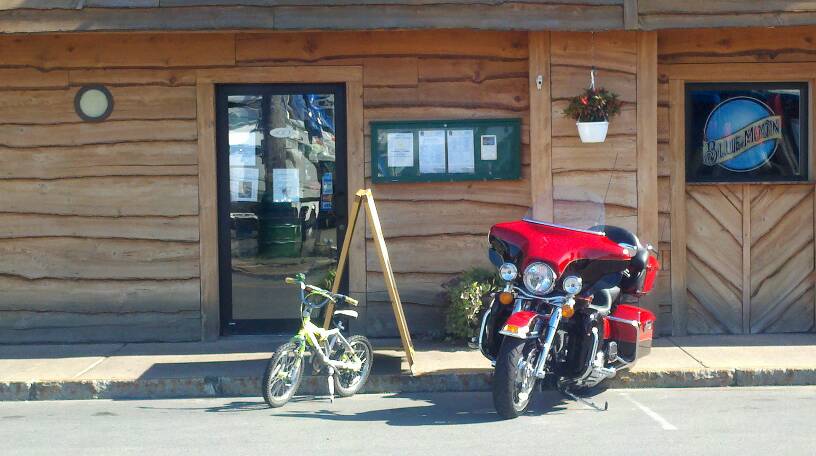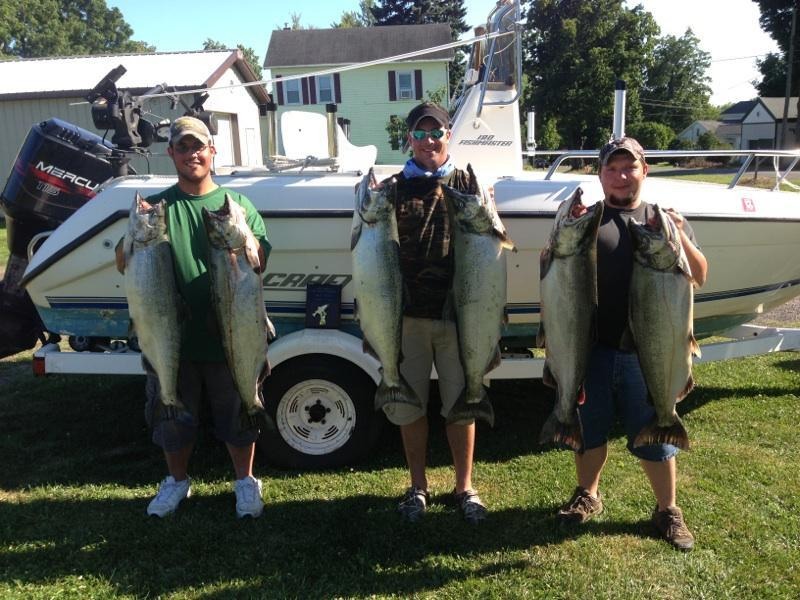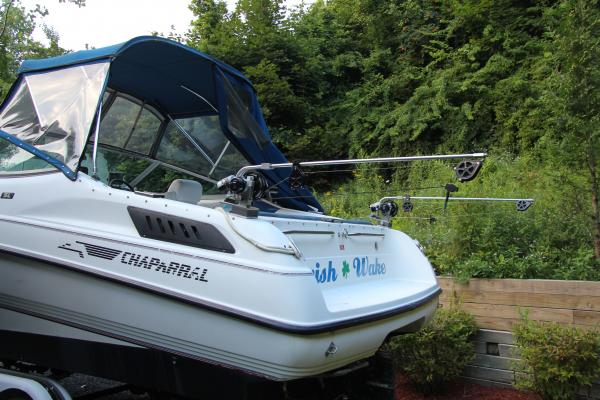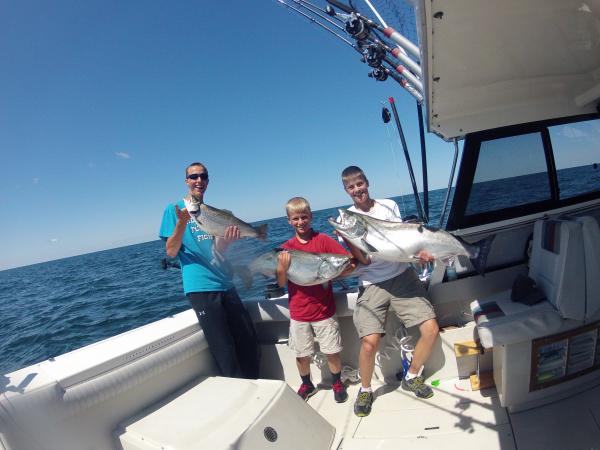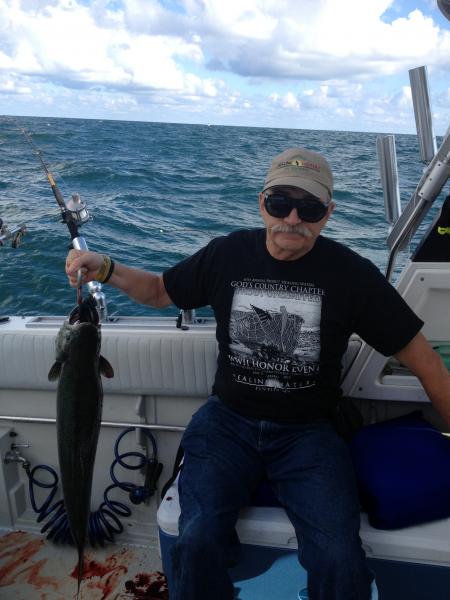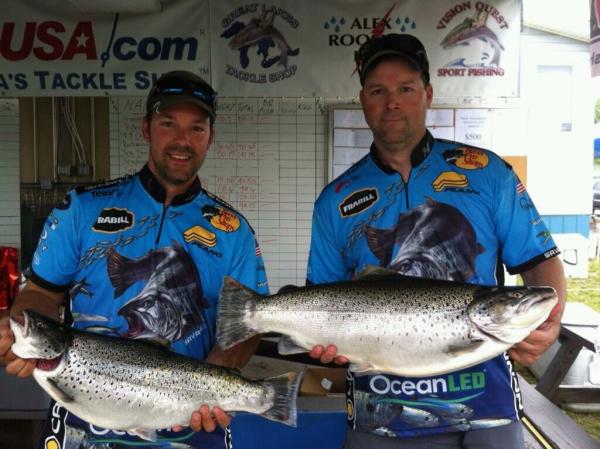-
Posts
414 -
Joined
-
Last visited
Everything posted by 1fish2fish
-
FYI- I just received this release from the DEC: Additional Deer Management Permits Available For Hunters The New York State Department of Environmental Conservation (DEC) today announced that approximately 35,000 Deer Management Permits (DMPs) will be issued to hunters who were previously denied permits during the initial application period earlier this fall. Leftover DMPs will also be available in several Wildlife Management Units (WMUs) beginning November 1, 2013. Deer Management Permits, which allow hunters to harvest antlerless deer, are issued for specific WMUs to control deer populations. In order to provide DMPs at point-of-sale locations DEC must anticipate the number of applicants in each WMU and assign a probability to each unit in order to issue the appropriate number of permits. This year, DEC received fewer permit applications than projected in many WMUs. To issue the remaining DMPs under Governor Cuomo's New York Open for Fishing and Hunting initiative, DEC randomly selects applicants who were previously denied permits in these affected units during the initial application period. DEC completed the selection last week and has begun mailing permits to selected applicants. The NY Open for Hunting and Fishing Initiative is an effort to improve recreational activities for in-state and out-of-state sportsmen and sportswomen and to boost tourism opportunities throughout the state. This initiative includes the streamlining of hunting and fishing licensing and reducing license fees, improved access for fishing at various sites across the state, and increasing hunting opportunities in various regions. In addition to those who were previously denied permits, applicants from the following WMUs may receive DMPs (the approximate number of permits to be mailed is in parenthesis). For WMU locations, refer the 2013-14 Hunting and Trapping Regulations Guide or visit DEC's website. • Hudson Valley Region: 3C (400), 3F (900), 3G (640), 3H (500), 3J (360), 3K (120), 3N (660), 3P (400) • Capital Region: 4B (60), 4C (190), 4F (970), 4G (540), 4H (310), 4K (200), 4O (310), 4P (670), 4R (70), 4T (820), 4U (70), 4W (200), 4Y (700), 4Z (120) • Adirondack Region: 5R (230), 5S (480), 5T (50) • Western Adirondacks/Eastern Lake Ontario Region: 6C (60), 6K (780), 6P (710), 6R (550), 6S (340) • Central New York Region: 7A (530), 7J (1300; all denied applicants), 7M (1890), 7P (470), 7R (3240), 7S (560) • Western Finger Lakes Region: 8M (370), 8P (540), 8S (470), 8T (600), 8W (560), 8X (1570) • Western New York Region: 9H (3500), 9J (1300), 9K (640), 9M (1360), 9N (1550; all denied applicants), 9P (570), 9T (230), 9W (1110), 9X (220), 9Y (240) Hunters not selected for a DMP will not receive a mailing from DEC. Selection for one of these permits will not affect any preference points issued to hunters who were not selected for their first choice area during the original application period. Additionally, in some WMUs, all applicants received permits during the initial application process or correction process, however, the DMP target was still not reached. In these units, DEC will reopen the DMP application process on a first-come, first-served basis. Hunters may apply for leftover DMPs at any DEC license sales outlet beginning Nov. 1, 2013. Leftover DMPs will not be available by phone, by mail or via the internet. Applicants who previously paid the $10.00 DMP application fee or those that are exempt from the application fee will not be charged for this additional application. Applications for leftover DMPs will be accepted for the following WMUs: 1C, 3M, 3R, 3S (bowhunting-only), 7F, 7H, 7J, 8A, 8F, 8G, 8H, 8J, 8N, 8R, 9A, and 9F. During this extended application period, DEC will issue DMPs for an individual WMU all day. The status of permits will be reviewed each night. As individual units are filled, they will be removed from the list of those available effective the following day, with no further applications accepted for those units. A list of units with available leftover DMPs will be routinely updated on DEC's website.
-
I received another press release yesterday from the DEC concerning additional stocking of Lake Sturgeon in the North Country: The NYS Department of Environmental Conservation has issued the following press release: Lake Sturgeon Restoration Continues In North Country Lake sturgeon will again be stocked in North Country waters as part of a restoration program for this threatened fish species, according to Judy Drabicki, Region 6 Director for the New York State Department of Environmental Conservation (DEC). This restoration effort is made possible in collaboration with the U.S. Fish & Wildlife Service (USFWS), the St. Regis Mohawk Tribe (SRMT), the New York Power Authority (NYPA) and the U.S. Geological Survey (USGS). On October 22, more than 10,000 fingerlings (four month old, 5- to 8-inch long fish) will be released into the St. Lawrence River and its tributaries. Approximately 7,000 lake sturgeon will be stocked in the St. Lawrence River in Ogdensburg at the Greenbelt boat launch off Riverside Ave. The Salmon River, St. Regis River, and Raquette River will receive a portion of the remaining fingerlings, continuing the St. Lawrence River tributary stocking program, which has been ongoing for several years. Under the restoration program, eggs were collected from mature fish at the New York Power Authority St Lawrence River Power Dam in Massena this spring. After fertilizing, the eggs were transported to the USFWS fish hatchery in Genoa, Wisconsin, and the hatched fish were nourished until they were large enough to be stocked back into the wild. Some of the fertilized eggs were taken to the DEC Oneida Hatchery for hatching, raising and release into other NY waters. 'This magnificent fish species was classified as threatened in New York State nearly 40 years ago, but stocking continues to help reverse population declines that occurred earlier this century," Drabicki said. "Previous stocking efforts in tributaries like these in St. Lawrence County have demonstrated success, with dozens of sturgeon ranging up to 48 inches being observed and some having reached maturity, when they are ready to spawn." David Stilwell of the USFWS said "One of the Service's goals is to work towards fully functional and sustainable landscapes. This multi-agency effort to reintroduce lake sturgeon to New York rivers brings us one step closer to restoring the natural heritage of New York waterways. We look forward to working together in partnership on future projects in the St. Lawrence River tributaries." Lake sturgeon once flourished in waters along New York's northern border and provided large commercial harvests near Buffalo. In 1885, harvests totaled 1,800 tons. Prior to the decline in the sturgeon population, these large fish inhabited all areas of New York's border waters on the west, north and northeast regions of the state, including Lake Erie, the Niagara River, Lake Ontario, the St. Lawrence River, Lake Champlain and in several St. Lawrence River tributaries up to 60 miles upstream. Activities to increase lake sturgeon populations include: protection from harvest, hatchery rearing, planning, habitat improvement, stocking of fingerlings, and outreach and education. In order to cover all these activities, DEC is cooperating with our federal partners, and the SRMT and NYPA. USFWS and USGS focus on raising the small fish in hatcheries and evaluating their survival and growth toward maturity then everyone is involved in communicating to the public about our efforts and how to protect the fish. The USFWS - New York Field Office helps support the lake sturgeon restoration program through the Fish Enhancement, Mitigation, and Research Fund (FEMRF), which is funded by NYPA as part of the relicensing of the St. Lawrence Hydroelectric Power Plant. The additional sturgeon reared at the DEC hatchery at Oneida Lake were stocked in the Genesee River downstream of Rochester and into Cayuga Lake in early October. Hatchery fingerlings are produced for bodies of water chosen as having the best prospects for restoration. One of the signs of program success has been experienced with mature fish being seen in spawning locations in Oneida Lake and the Oswegatchie River, when they are ready to spawn. In addition, small fish have been collected from Oneida Lake that were naturally spawned. In addition, NYPA has undertaken efforts to promote lake sturgeon restoration by installing two pairs of artificial lake sturgeon spawning beds in the St. Lawrence River near Waddington and Massena, N.Y., during 2007 and 2012, respectively. Since 2008, hundreds of lake sturgeons have been observed with underwater cameras at the Waddington beds. Knowledge gained from these efforts can provide a blueprint for future lake sturgeon spawning beds. Inquiries about this threatened fish restoration program and other similar projects can be directed to DEC, Bureau of Fisheries in Watertown, at (315) 785-2263. Additional information on lake sturgeon can be found on DEC's website.
-
I just received this report from the DEC and thought you'd find it interesting. --------------------------------------------------------------------- Hello, The NYS Department of Environmental Conservation has issued the following press release: Lake Sturgeon Released into the Genesee RiverNew York State Department of Environmental Conservation (DEC) staff and federal and local partners today released 1,000 fingerling lake sturgeon into the Genesee River as part of an effort to restore a healthy population of this native fish species. This event marks the third year a release has taken place. The addition of these young fish to the Genesee River will increase the chance that the river will once again be the home to a re-established and thriving Lake Sturgeon population. "This project clearly demonstrates how great partnerships and good science together have contributed to the success of lake sturgeon restoration efforts," said Paul D'Amato, DEC Region 8 Regional Director. "This species of fish nearly disappeared from these waters, but thanks to the combined efforts of dedicated experts, lake sturgeon in the Genesee Rive now have a great chance to return to a healthy, thriving, self-sustaining population." Regional Director D'Amato noted the commitment and hard work of partners in this effort, including research ecologist Dr. Dawn Dittman of the USGS Great Lakes Science Center; Scott Schlueter, Fish and Wildlife Biologist of the U.S. Fish and Wildlife Service; Dr. Jeff Wyatt, Director of Animal Health and Conservation for the Seneca Park Zoo; and DEC staff. Lake sturgeon is a native fish species that has been designated a species of concern across the Great Lakes Region. Historically abundant in Lake Ontario, this unique primitive fish has virtually disappeared due to over fishing and habitat degradation. Among the activities being undertaken to eventually remove lake sturgeon from the New York threatened species list include: protection from fishing harvest, habitat improvements, stocking of fingerlings, and evaluations of the success these direct efforts. The U.S. Fish and Wildlife Service's New York Field Office supports the collaborative state DEC lake sturgeon restoration program through funding provided from the U.S. Fish and Wildlife Service's Fish Enhancement, Mitigation, and Research Fund (FEMRF), a settlement with the New York Power Authority resulting from the relicensing of the St. Lawrence Power Project. The funding facilitates the cooperative sturgeon conservation field efforts in the St. Lawrence River valley, as well as the rearing of sturgeon fingerlings at the U.S. Fish and Wildlife Service Genoa National Fish Hatchery (WI). DEC and federal partners have been following a restoration plan that includes a minimum of five years of fingerling stocking in selected tributaries of Lake Ontario and the St. Lawrence River to facilitate the reestablishment of lake sturgeon populations in those waters. The Genesee River had a substantial lake sturgeon presence into the early 1900s that included "monster" sturgeon. The river has been the focus of recent restoration activities that included habitat evaluation, stocking of 1,900 fingerlings in 2003 and 2004, and evaluation of the success of those fish. The evaluation results indicate that a number of those released sturgeon are residing in the Genesee River and nearby Lake Ontario and growing well, with weights ranging from 10 to 25 pounds.
-
I had the pleasure of fishing from this boat for many years with my buddy Mike. Many fish were caught out of this boat over the past few years. We had the boat in rough and calm water and the it never failed. Mike was meticulous with maintenance and service. I would consider this the perfect all-around boat whether you are fishing or enjoying the water with friends and family. Mike and his wife used to attend the Oswego Harborfest every year. The boat was converted from a fishing to a pleasure craft for the event. I wish I had the money and the boat would be mine! Jim
-
I've noticed that in some of Nick's (Bobs_boy) videos Theresa uses some type of rod butt cushion ball. Maybe Nick or Theresa could comment in what type they are using. Jim
-
Happy Birthday Ray. Hope you have a great day! Jim
-

7/25/13 Apple Boy Sodus
1fish2fish replied to kylew's topic in New York Fishing Reports - Lake Ontario (South Shore)
-

2013 Sodus Bay Healing Waters Salmon Slam - August 3rd
1fish2fish replied to TOP SECRET's topic in Open Lake Discussion
-
I have found that the quickest and cleanest way to fillet all of my trout and salmon is to go to Wright's Landing in Oswego and pay the guy three bucks per fish!!! Jim
-
Boa grips are great for handling the fish in the boat, and some have a built-in scale to get a quick weight. The fish holder is great for handling fish in the boat too, and is much easier for kids to hold a fish up for a picture (and you don't get your hands all slimmy). Most tackle shops have them. Jim
-
As long as the back of my neck felt cooler, so did the rest me. You wet the towel, wring it out, snap the ends apart and I guess the evaporation process does the rest! I did find that you need to keep rotating it occasionally to find a cool spot. For 12 - 15 bucks a pop, I'd recommend it. Jim
-
Congratulations to Captain Brian Garret and his team- first mate and excellent helmsperson Marlene Garret, and crewmen Jim and Charlie for their come-from-behind win. Marlene did an excellent job keeping them over fish, and Brian, Jim and Charlie didn't drop one fish on day two! I observed on their boat on day two and learned a lot (I promised I wouldn't tell). Jim
-
I just searched Wally World (Walmarts) and they carry quite a few different types of cooling towels a couple bucks cheaper than Lowe's. Jim
-
If you go to Lowe's, you can pick up the "Mission Blue Polyester EnduraCool Instant Cooling Towel". They list for $14.98 and come in about three different colors. They also come in bandana shapes. I bought one and used it while mowing the grass, and also at the Osewgo Pro/Am. It works pretty good when you wrap it around your neck. I saw a few other guys using them at the tournament. Jim
-
Rod, I'm sorry to hear of your disqualification. But, if you wasted the whole day fishing, only to find out at the weigh in you fished with too many poles, that observer should be forbidden from participating in Pro/Am tournaments for life. Being an observer isn't a free ride on a boat, or earning some money over a weekend. It comes with a lot of responsibility. First, he/she is representing another team in the tournament. He/she should have read and become familiar with the tournament rules BEFORE coming aboard your boat (especially this Oswego tournament, because of the number of rules changes from previous Pro/Am's). And should have a copy the the rules to refer to DURING the tournament. I've been fishing and observing Pro/Am's and Invitational's all along Lake Ontario for the past three years and probably the number one thing I find myself doing is COUNTING RODS. Every time a Captain or crew member grabs a new rod, I count. So far, I've never had to disqualify a team for rules infractions. (I hope I never have to.) But I would think if I 'observed' a rule about to be broken, and I had time to challenge the Captain for an 'honest' mistake, I think I have the right to do it. Just my opinion, Jim
-
I'll third that! Navionics
-

kinda excited...
1fish2fish replied to ray koziatek's topic in Tournament Talk, Shows, Events & Seminars
Great to hear from you again Ray! I've missed your posts over thew last few months! I hope Wayne knows what he's got himself into! I look forward to seeing you in Oswego. Does Wayne allow buffy fishing on his boat?? Jim -
Dane, l'll be there also. Jim
-

observer for wilson harbor invatational needed
1fish2fish replied to pacific time's topic in Open Lake Discussion
Hi Todd, Sorry about the phone number change. I thought you had my cell. I'll be there. Jim -

2013 Sodus Bay Healing Waters Salmon Slam - August 3rd
1fish2fish replied to TOP SECRET's topic in Open Lake Discussion
-

2012 Sodus Bay Healing Waters Salmon Slam - August 4th
1fish2fish replied to TOP SECRET's topic in Open Lake Discussion
Hi Nick, I'll be back again this year to help where needed. Let me know if you and Theresa want to get together to discuss your plans. Jim -

Bear Creek
1fish2fish replied to rabhunt's topic in New York Fishing Reports - Lake Ontario (South Shore)
Is the boat launch still limited to town of Ontario residents only? Jim


